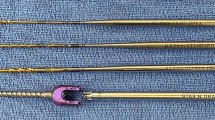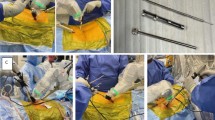Abstract
Study Design
Retrospective review of 1 surgeon’s posterior spinal fusion cases.
Objectives
To assess the safety and efficacy of using power tools versus using manual tools to create pedicle tracts and place pedicle screws.
Summary of Background Data
This is the first study to report on the safety and efficacy of pedicle tract creation and pedicle screw placement using power tools.
Methods
The study included 442 cases and 6412 pedicle screws. The manual tool cohort included 159 cases (1,870 screws, January 1, 2004 to June 30,2007). The power tool cohort included 283 cases (4,542 screws, January 1,2008 to August 29,2012). Patient charts and radiographs were reviewed. The researchers recorded the number of screws placed and their positions. Screws were classified as failed if the patient returned to surgery for revision or removal of the screw. Operating and fluoroscopy times were analyzed by cohort overall and for diagnosis-specific subsets.
Results
The incidence of injury resulting from pedicle screw placement was 0.00% (0 of 1,870) with the manual method and 0.02% (1 of 4,542) with power (p =.5211). One screw, placed with power, was assumed to have caused a minor hemothorax, which was successfully treated with a chest tube. There were no neurologic or vascular injuries or other complications attributable to a pedicle screw in either group. Screws placed with power were removed or revised because of problems attributable to the pedicle screw one-sixth as often as those placed using manual tools: 2 of 1,410 (0.14%) versus 8 of 948 (0.84%) (p =.024). Fluoroscopy times in the power cohort were two-thirds as long as those in the manual cohort (p <.001). Operating times were not significantly different (p =.109).
Conclusions
The use of power tools to create pedicle tracts and place pedicle screws was associated with shorter fluoroscopy times and a lower revision rate compared with using manual tools. Both techniques posed similar low risks of injury to the patient.
Similar content being viewed by others
References
Asghar J, Samdani AF, Pahys JM, et al. Computed tomography evaluation of rotation correction in adolescent idiopathic scoliosis: a comparison of an all pedicle screw construct versus a hook-rod system. Spine (Phila Pa 1976) 2009;34:804–807
Dobbs MB, Lenke LG, Kim YJ, et al. Selective posterior thoracic fusions for adolescent idiopathic scoliosis: comparison of hooks versus pedicle screws. Spine (Phila Pa 1976) 2006;31:2400–4.
Liljenqvist U, Lepsien U, Hackenberg L, et al. Comparative analysis of pedicle screw and hook instrumentation in posterior correction and fusion of idiopathic thoracic scoliosis. Eur Spine J 2002;11:336–43.
Suk SI, Kim JH, Kim SS, Lim DJ. Pedicle screw instrumentation in adolescent idiopathic scoliosis (AIS). Eur Spine J 2012;21:13–22.
Wu X, Yang S, Xu W, et al. Comparative intermediate and long-term results of pedicle screw and hook instrumentation in posterior correction and fusion of idiopathic thoracic scoliosis. J Spinal Disord Tech 2010;23:467–73.
Yilmaz G, Borkhuu B, Dhawale AA, et al. Comparative analysis of hook, hybrid, and pedicle screw instrumentation in the posterior treatment of adolescent idiopathic scoliosis. J Pediatr Orthop 2012;32:490–9.
Kim YJ, Lenke LG, Bridwell KH, et al. Free hand pedicle screw placement in the thoracic spine: is it safe? Spine (Phila Pa 1976) 2004;29:333–42; discussion 42.
Kim YJ, Lenke LG, Cho SK, et al. Comparative analysis of pedicle screw versus hook instrumentation in posterior spinal fusion of adolescent idiopathic scoliosis. Spine (Phila Pa 1976) 2004;29:2040–8.
Suk SI, Lee CK, Kim WJ, et al. Segmental pedicle screw fixation in the treatment of thoracic idiopathic scoliosis. Spine (Phila Pa 1976) 1995;20:1399–405.
Brown CA, Lenke LG, Bridwell KH, et al. Complications of pediatric thoracolumbar and lumbar pedicle screws. Spine (Phila Pa 1976) 1998;23:1566–71.
Esses SI, Sachs BL, Dreyzin V. Complications associated with the technique of pedicle screw fixation: a selected survey of ABS members. Spine (Phila Pa 1976) 1993;18:2231–8; discussion 8-9.
Liljenqvist UR, Halm HF, Link TM. Pedicle screw instrumentation of the thoracic spine in idiopathic scoliosis. Spine (Phila Pa 1976) 1997;22:2239–45.
Lonstein JE, Denis F, Perra JH, et al. Complications associated with pedicle screws. J Bone Joint Surg Am 1999;81:1519–28.
Suk SI, Kim WJ, Lee SM, et al. Thoracic pedicle screw fixation in spinal deformities: are they really safe? Spine (Phila Pa 1976) 2001;26:2049–57.
Elliott D. The use of power tools in the insertion of cortical bone screws. Injury 1992;23:451–2.
Ansell RH, Scales JT. A study of some factors which affect the strength of screws and their insertion and holding power in bone. J Biomech 1968;1:279–302.
Mahajan A, Vadapalli S, Steele B. Biomechanical evaluation of the POWEREASE Tapper/Driver System. Medtronic Internal White Paper 2012. PMD0007528-1.0:1-4.
Auerbach JD, Weidner ZD, Milby AH, et al. Musculoskeletal disorders among spine surgeons: results of a survey of the Scoliosis Research Society membership. Spine (Phila Pa 1976) 2011;36:E1715–21.
Athwal GS, Bueno Jr RA, Wolfe SW. Radiation exposure in hand surgery: mini versus standard C-arm. J Hand Surg Am 2005;30:1310–6.
Devalia KL, Peter VK, Madanur MA, Braithwaite IJ. Exposure of the thyroid to radiation during routine orthopaedic procedures. Acta Orthop Belg 2006;72:615–20.
Giordano BD, Baumhauer JF, Morgan TL, Rechtine II GR. Patient and surgeon radiation exposure: comparison of standard and mini-C-arm fluoroscopy. J Bone Joint Surg Am 2009;91:297–304.
Muller LP, Suffner J, Wenda K, et al. Radiation exposure to the hands and the thyroid of the surgeon during intramedullary nailing. Injury 1998;29:461–8.
Dal Maso L, Bosetti C, La Vecchia C, Franceschi S. Risk factors for thyroid cancer: an epidemiological review focused on nutritional factors. Cancer Causes Control 2009;20:75–86.
Ward EM, Jemal A, Chen A. Increasing incidence of thyroid cancer: is diagnostic scrutiny the sole explanation? Future Oncol 2010;6:185–8.
Zhu C, Zheng T, Kilfoy BA, et al. A birth cohort analysis of the incidence of papillary thyroid cancer in the United States, 1973–2004. Thyroid 2009;19:1061–6.
Shi YB, Binette M, Martin WH, et al. Electrical stimulation for intra-operative evaluation of thoracic pedicle screw placement. Spine (Phi-la Pa 1976) 2003;28:595–601.
Watanabe K, Lenke LG, Matsumoto M, et al. A novel pedicle channel classification describing osseous anatomy: how many thoracic scoliotic pedicles have cancellous channels? Spine (Phila Pa 1976) 2010;35:1836–42.
Hicks JM, Singla A, Shen FH, Arlet V. Complications of pedicle screw fixation in scoliosis surgery: a systematic review. Spine (Phila Pa 1976) 2010;35:E465–70.
Samdani AF, Ranade A, Saldanha V, Yondorf MZ. Learning curve for placement of thoracic pedicle screws in the deformed spine. Neuro-surgery 2010;66:290–4; discussion 4-5.
Samdani AF, Ranade A, Sciubba DM, et al. Accuracy of free-hand placement of thoracic pedicle screws in adolescent idiopathic scoli-osis: how much of a difference does surgeon experience make? Eur Spine J 2010;19:91–5.
Billingsley KG, Morris AM, Green P, et al. Does surgeon case volume influence nonfatal adverse outcomes after rectal cancer resection? J Am Coll Surg 2008;206:1167–77.
Shah SN, Wainess RM, Karunakar MA. Hemiarthroplasty for femoral neck fracture in the elderly surgeon and hospital volume-related outcomes. J Arthroplasty 2005;20:503–8.
Shervin N, Rubash HE, Katz JN. Orthopaedic procedure volume and patient outcomes: a systematic literature review. Clin Orthop Relat Res 2007;457:35–41.
Senaran H, Yazici M, Karcaaltincaba M, et al. Lumbar pedicle morphology in the immature spine: a three-dimensional study using spiral computed tomography. Spine (Phila Pa 1976) 2002;27:2472–6.
Zindrick MR, Knight GW, Sartori MJ, et al. Pedicle morphology of the immature thoracolumbar spine. Spine (Phila Pa 1976) 2000;25: 2726–35.
Author information
Authors and Affiliations
Corresponding author
Additional information
DAS (none); DLS (none); LMA (none); YJ (none).
Rights and permissions
About this article
Cite this article
Seehausen, D.A., Skaggs, D.L., Andras, L.M. et al. Safety and Efficacy of Power-Assisted Pedicle Tract Preparation and Screw Placement. Spine Deform 3, 159–165 (2015). https://doi.org/10.1016/j.jspd.2014.07.001
Received:
Revised:
Accepted:
Published:
Issue Date:
DOI: https://doi.org/10.1016/j.jspd.2014.07.001




